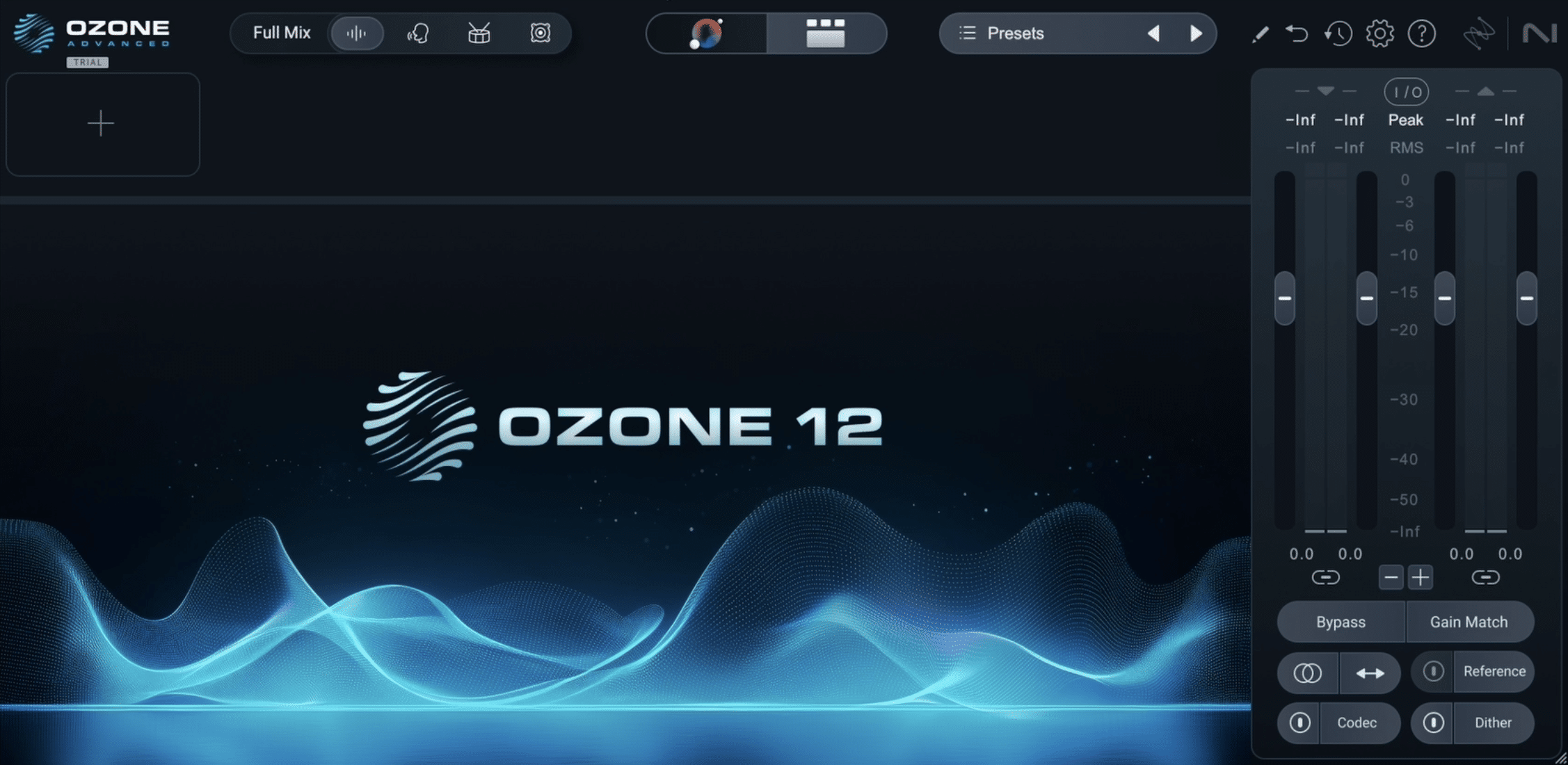
Share This Post
iZotope’s Ozone 12 is the newest addition to their mastering suite lineup, introducing features like the IRC 5 Maximizer, Unlimiter, Stem EQ and more. I’ve spent time putting it through its paces in the 2026 mastering workflow to see how it stacks up against its predecessors and competitors. At $499, it sits firmly in the premium range — but does it deliver the value and performance that price suggests? Here’s my in-depth Izotope Ozone 12 review, where we’ll break down what’s new, what’s changed, and whether it’s the right fit for your mastering chain.
What Is iZotope Ozone 12?
Ozone 12 Advanced is iZotope’s all-in-one mastering suite, bringing together EQ, compression, limiting, and imaging tools powered by AI-driven workflows for quick, streaming-ready masters. This latest version introduces new additions like the IRC 5 Maximizer, Unlimiter, Bass Control and Stem EQ, expanding its flexibility for modern production needs.
At $199 for upgrades (or higher in bundled options, see iZotope’s site), Ozone 12 sits at the higher end of the mastering market — but promises professional-grade results and streamlined control for both seasoned engineers and newcomers alike.
Specs overview:
Supports stereo and multichannel projects up to 192kHz
VST3 / AU / AAX formats; compatible with all major DAWs
Includes AI Assist via the Master Assistant for quick genre-based starting points
Pricing: ~$499 standalone, ~$299 for upgrades
Whether you’re upgrading from Ozone 10 or exploring it for the first time, Ozone 12 aims to be a complete mastering solution — combining intelligent processing with iZotope’s signature polish.
(Ozone 12, iZotope Ozone 12, Ozone 12 mastering, Ozone 12 plugin)
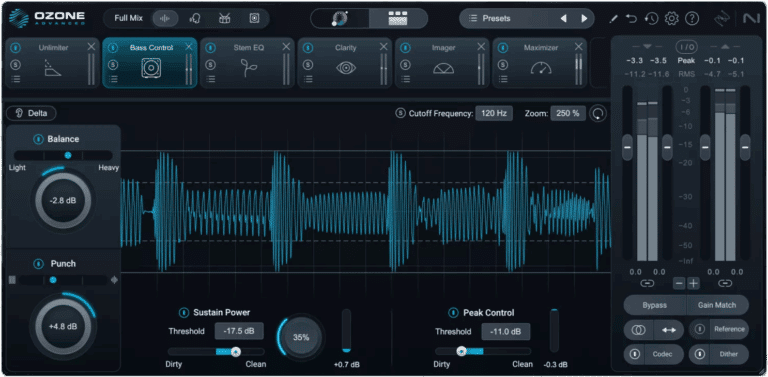
Ozone 12 New Features: Dxt3r’s Take
IRC 5 Maximizer Mode
The IRC 5 is the latest version of iZotope’s Intelligent Release Control limiting algorithm, found in the Maximizer module. It builds on IRC IV with improved transient handling and adaptive multiband limiting, applying frequency-dependent gain control for cleaner, louder results.
Test results across genres:
EDM: achieved around -6 LUFS with decent punch, though slightly thinner than Waves L4 in “Modern” mode.
Hip-Hop: Maintained detail but slightly softened low-end compared to Ozone 10’s IRC IV.
Acoustic: Transparent and open, comparable to previous IRC versions.
Ozone 12 IRC 5, IRC 5 maximizer, Ozone 12 maximizer, iZotope Ozone 12
Unlimiter
The Unlimiter is a brand-new, standalone module in Ozone 12 — an industry-first concept designed to “undo” overly compressed or limited audio by restoring lost dynamics. Powered by machine learning, it analyzes brickwalled mixes and intelligently expands transients, aiming to breathe life back into over-processed material.
It’s a bold idea that sounds almost revolutionary, especially for mastering engineers dealing with crushed mixes. In practice, while similar results can be achieved by carefully combining existing expansion and transient tools, Unlimiter makes that process faster and simpler — putting dynamic restoration in one dedicated place rather than requiring a chain of plugins.
Test results (-8 LUFS target):
Hip-Hop: Subtle improvement to transient snap — 808s and kicks regained some punch and movement without distorting the mix. However, extreme settings occasionally produced a hollow low-end.
Rock: Helped recover pick attack and snare transients on dense mixes. The restored dynamics opened up the stereo image slightly, though pushing it too far made the upper mids sound detached.
Ozone 12 Unlimiter, iZotope Unlimiter, Ozone 12 dynamic restoration
Stem EQ
The Stem EQ in Ozone 12 introduces AI-powered stem separation, allowing you to isolate and adjust vocals, drums, bass, or other instruments directly within a stereo mix — no need to go back to the original session. It’s designed to help mastering engineers make subtle, targeted EQ tweaks when full mix access isn’t available.
While it’s convenient to have this capability built into Ozone, other tools — notably Logic Pro’s stem separation — currently offer more precise isolation and greater flexibility, allowing you to apply any plugin chain per stem, not just EQ. Still, Ozone’s integrated approach makes quick tonal fixes far more efficient during mastering.
Test results (-8 LUFS target):
Pop Mix – Vocals: A gentle boost around 2 kHz brought forward presence and clarity, though occasional bleed from percussion was noticeable in busy mixes.
Pop Mix – Drums: A modest 200 Hz cut tightened the low end without compromising kick weight, as long as adjustments stayed subtle.
Bass Control
The Bass Control module in Ozone 12 is a dedicated tool for managing and refining the low-end balance of your mix or master. It intelligently analyzes sub and bass frequencies, helping you tighten, focus, and translate the low end more consistently across playback systems — from studio monitors to club PAs and car stereos.
It’s particularly handy for sessions where the low end feels either weak or overly boomy. By targeting the fundamental and harmonic regions separately, Bass Control makes it easy to sculpt depth and punch without smearing the mids or muddying the mix.
While you can achieve similar results using tools like Waves RBass or Logic Pro’s Phat FX (especially when combined with multiband compression or dynamic EQ), Bass Control brings that workflow into a single, focused module — quicker to dial in and more cohesive for mastering.
Test results (-8 LUFS target):
Electronic Mix: Light tightening around 60–80 Hz added focus and punch, translating cleanly to smaller systems while keeping club-ready weight.
Pop Mix: Subtle shaping improved bass definition and stereo balance, preserving warmth without masking the kick.
Other Updates
- Master Assistant 2.0: You can now select a custom flow: pick which modules you want included, set your target loudness (LUFS), and choose from multiple genre presets. Improved analysis options: you can capture a longer listening period
- The Stabilizer module now has 25 new genre targets to adapt EQ more intelligently.
Ozone 12 features, iZotope Ozone 12, Ozone 12 mastering suite
Testing Ozone 12: Dxt3r’s Experience
In real-world sessions, Ozone 12 Advanced demands far more processing power than expected. Even on a high-end M2 MacBook Pro and a Ryzen 9 desktop, CPU spikes were frequent — especially when combining IRC 5, Stem EQ, and Unlimiter. Large projects pushed system resources hard, sometimes causing temporary playback dropouts at higher sample rates. It’s a capable suite, but one that clearly favors brute-force power over efficiency.
At $499 standalone (and roughly $299 for upgrades), Ozone 12 sits at the top of the mastering-plugin price range. That premium might be easier to justify if its new features consistently outperformed competitors, but in practice, Waves L4 Ultramaximizer and Masterplan both achieve equally loud, cleaner results with far less CPU load — and at a fraction of the cost.
The new IRC 5 Maximizer brings improved transient definition and an expanded sense of punch, but it tends to lift the upper mids and highs slightly, which can make some masters feel a bit hyped. It shines on EDM, pop, and brighter R&B, delivering crisp, forward results, yet on Hip-Hop and bass-heavy genres, that extra sheen can throw off tonal balance. While powerful, it’s not always as transparent or natural-sounding as earlier IRC modes.
Overall, Ozone 12 Advanced is an ambitious update with thoughtful AI-driven tools, but the high CPU usage, premium pricing, and occasional tonal coloration make it harder to recommend as an all-round mastering workhorse. It’s forward-thinking and flexible — just not the performance upgrade many were hoping for.
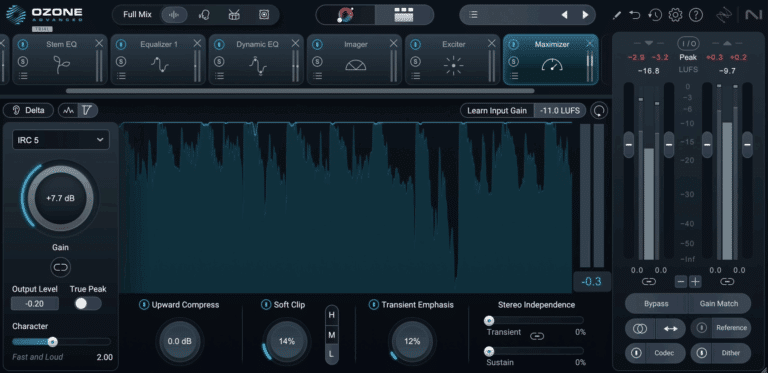
iZotope Ozone 12 Final Score: 2.5 / 5
Ozone 12 Advanced isn’t the leap forward iZotope fans might have hoped for. While the new modules and AI-driven tools show promise, the heavy CPU load, premium pricing, and uneven transparency make it difficult to recommend over more efficient alternatives.
For most engineers, Ozone 10, Masterplan, or Waves L4 Ultramaximizer still deliver cleaner results with less friction — and for far less money. If you prefer to work with a Waves-based mastering chain that matches or even surpasses what Ozone 12 can do, you’ll find our full setup and recommendations [here]. Unless you’re deeply invested in iZotope’s workflow or curious about its new AI features, Ozone 12 is an easy skip for now.
Curious anyway? Check it out on iZotope’s official site — but don’t say Dxt3r didn’t warn you.
More To Explore
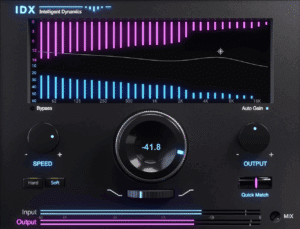
Waves IDX Intelligent Dynamics Review 2026: Anything New or Just Another “Smart” EQ?
Share This Post The Waves IDX Intelligent Dynamics is a fresh take on compression, designed to tackle excess energy in your tracks with surgical precision.
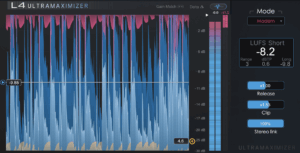
Waves L4 Ultramaximizer 2025 Review: Great or Average?
Share This Post The Waves L4 Ultramaximizer is the new kid on the block, built for loud, clean masters in 2025’s streaming era. I’ve tested



